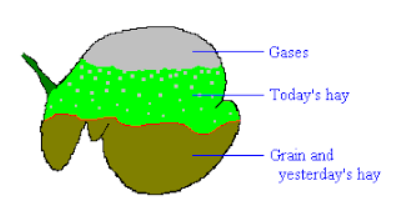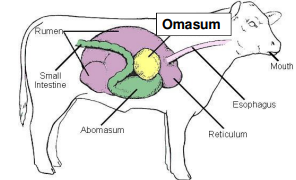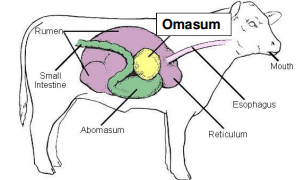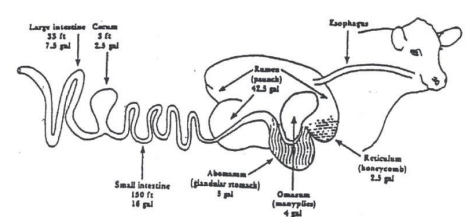Digestive GI Tract Anatomy & Physiology
1/62
There's no tags or description
Looks like no tags are added yet.
Name | Mastery | Learn | Test | Matching | Spaced |
|---|
No study sessions yet.
63 Terms
Digestion
Reduction/breakdown of feed particles for absorption to support body functions
Digestive system is composed of 2 categories of organs
Digestive organs: form tube that runs from mouth to anus (GIT)
Accessory digestive organs
Digestible
Able to be broken down & absorbed
Palatable
Acceptable/satisfactory to eat
Structure and function of GIT varies depending on
diet of the animal: herbivores, carnivores, omnivores
Monogastric Animals
1 simple stomach
Foregut Fermenters/Ruminants
3 mixing & fermentations chambers (microbial populations eat plant material and ferment it into nutritious form) before 1 true stomach chamber
Ex. cattle, goats, sheep
Typically fills rumen rapidly, taking little or no time to chew its meal, and finds a place to rest and chew
Microbial fermentation in forestomach
Rumination/Ruminating
Chewing cud
Hindgut Fermenters
Fermentation occurs in large intestines & cecum (ex. rabbits and horses)
Microbial fermentation of roughage occurs after stomach in large intestines (cecum & colon)
General GI Tract
Mouth (salivary glands) → esophagus → stomach → small intestine (pancreas/liver) → large intestines = cecum + colon → rectum
Mouth
Prehend food
Initiate mechanical digestion: break food into smaller particles that increase surface area for enzymes involved in chemical digestion
Initiate chemical digestion: saliva is produced by paired glands & added to food as it’s chewed to provide moisture (soften/shape food into swallow-able form), enzymes (breakdown food), ions (alkaline buffer), evaporative cooling (dogs)
Move food toward pharynx for swallowing
Esophagus
Muscular tube transports food
As stomach expands, fold of stomach closes against lower end of esophagus (sphincter)
Stomach (Carnivores & Omnivores)
Monogastric: 1 stomach compartment (acidic)
Location: left, upper quadrant of abdomen
Functions: mechanical & chemical digestion (gastric glands line stomach), limited absorption, temporary storage
Stomach (Herbivores)
Monogastric: 1 stomach compartment
Foregut fermenter/ruminant: 4 stomach compartments
Cows stomachs ≥ 50 gallons
Sheep stomachs ≥ 12 gallons
Small Intestine Structure
Structure (DJI)
Duodenum (1st short segment, receives secretions from pancreas, gallbladder, liver)
Jejunum
Ileum
Functions: chemical & mechanical digestion, transport food, absorb nutrients
Pancreas
Location: “L” shaped gland sits in abdomen along greater curvature of stomach next to duodenum
Functions: exocrine or digestive, endocrine
Releases 2 types of hormones: insulin and glucagon
Pancreas Exocrine Functions
Secrete substances through duodenum (duct to intestines)
Enzymes: digest food
Bicarbonate: buffer food coming from stomach into intestines
Pancreas Endocrine Functions
Secrete substances of hormones into blood for systematic
Insulin: stimulate glucose uptake by cells
Glucagon: stimulate glucose production & release from liver
Liver
Location: immediately below diaphragm, over stomach
Functions: digestive, vascular, metabolic
Digestive: produce bile (bile salts digest lipids and eliminate waste/feces)
Vascular
Metabolic: make, store, breakdown carbohydrates, lipids & proteins
Bile
Green-yellow fluid
Composition: WATER, bile salts (acids), cholesterol, bilirubin (pigment made during breakdown of red blood cells), bicarbonate, phospholipids, detoxification products, drugs, hormones, antibiotics, toxins, copper, zinc, mercury
Functions: break fat into small droplets to assist in chemical digestion
Get rid of waste products
Gallbladder
Location: tucked between liver and small intestines
Function: storage site for bile between meals
Horses have no gallbladder (they still make bile) because they’re constantly eating so they release a little bile every time they graze
Large Intestine
Functions
Absorb water (compact fecal matter)
Absorb vitamins
Secrete mucus
Transport/store fecal matter
Monogastric herbivores: absorb nutrients and perform fermentation
Structure
Carnivores: simple, tubular colon, poorly developed cecum
Nonruminant herbivores: extensive colon & cecum (horses, guinea pigs, rats, rabbits) modifications of cecum and colon allow fermentative digestion in hindgut
CCR
Cecum: blind-ended pouch, beginning of colon,
Colon: longest part
Rectum: short, end segment of GIT
Rectum
Last portion of large intestine
Mucus-secreting glands lubricate and aid passage of contents
Anus
Terminal opening of GIT
Internal sphincter: unconscious control
External sphincter: voluntary control
Avian Digestive Tract
Beak/mouth → esophagus → crop → proventriculus → gizzard (ventriculus) → small intestines → cecum → large intestines → rectum → cloaca/vent
Beak/mouth
No teeth
Glands secrete saliva
Tongue
Crop
Not all birds have crop (waterfowls don’t)
Storage site until rest of digestive tract is ready to receive more feed
When early empty, crop sends signals to brain so more food in consumed
Proventriculus
Glandular stomach of acidic and enzymatic digestion
Gizzard (Ventriculus)
Mechanical stomach
Pebbles or grit
Grinds food down
Small Intestine
Duodenum: contributions pancreas & liver/gall bladder
Jejunum: Meckel’s Diverticulum (at junction of jejunum and ileum, remnants of yok sac after yok has been absorbed that supplied nutrients first days after hatching)
Ileum
Cecum (Ceca)
Blind pouches at junction of small & large intestines
Re-absorb water; ferment coarse feed, produce 8 B vitamins
Evacuate contents 2-3 times per day
Coarse Feed
A feeding stuff containing a relatively large percentage of crude fiber or water
Large Intestine
Re-absorb water
Cloaca or Vent
Common orifice (opening) for waste elimination, breeding, egg laying in females
What is the function of ruminant systems?
To allow the animal to use roughage (cellulose) as a source of energy
Fermentation
Enzymatic breakdown of energy-rich compounds in an anaerobic environment
Oral Cavity of Ruminants
Dental pad
Teeth
Salivary glands: lubricate feed, provide liquid for bacteria & protozoa, buffer rumen (pH 6.2-6.8), recirculate nitrogen & minerals
Cows produce 100-150 liters of saliva/day
Ruminant Digestive Tract
Mouth → esophagus → rumen → reticulum → omasum → abomasum → small intestines (duodenum, jejunum, ileum) → cecum → large intestines → rectum
Esophagus
Ruminants chew food, swallow food, regurgitate it, re-chew it, re-swallow again (constant 2-way street)
Eructating/Eructation
Burping
Fermentation in stomach chambers produces gases which must be expelled by burping (1-2 times per minute - carbon dioxide and methane)
Rumen (Fore Stomach)
Largest stomach chamber
Structure: muscular sacs lined by papillae (finger-like projections increase surface area to absorb more nutrients) separated by muscular folds
Warm, anaerobic, pH 5.8 to 6.4 = ideal environment for bacteria, protozoa, fungi
Function: fermentation
Location: entire left side of abdomen from diaphragm to pelvis
Never empties

Why does the rumen/reticulum have always regular, rhythmic contractions?
Expel/burp built-up carbon dioxide and methane gases
Regurgitate partially digested plants for further breakdown (rumination or cud chewing)
Move feed particles that have been reduced in size by cud chewing and microbial action into 3rd stomach chamber
Reticulum (Forestomach)
Smallest stomach chamber
Structure: muscular sac lines by honeycomb ridges
Function: fermentation
Location: just below entrance of esophagus on left side of cranial (front) end of abdomen
If a cow eats something heavy like metal, the weight could make it drop into reticulum first
Cow Rumination Rate
3 ruminations every 2 minutes
Sheep & Goat Rumination Rate
2 ruminations every 1 minute
What is the benefit of fermentation for the ruminant?
Carbs in feed are broken down through microbial fermentation & digestion into volatile fatty acids (VFAs)
Volatile Fatty Acids (VFAs)
Acetic acid
Butyric acid
Propionic acid
Lactate
VFAs absorbed through rumen wall into bloodstream OR pass through rumen for absorption in omasum/abomasum
Converted to glucose, adipose tissue, milk fat, other
Provide 50-80% of ruminant’s total energy needs
What makes up a ruminant diet?
Protein + Non-Protein Nitrogen
Protein
Microbial enzymes break down protein into amino acids
Rumen Undegradable Protein
Some dietary protein escapes rumen & is absorbed in small intestines
Non-Protein Nitrogen
NH3 (ammonia)
Absorbed through rumen wall & transported to liver to be converted to urea (another non-protein nitrogen compound)
Why is okay to feed non-protein nitrogen (such as urea) to ruminants?
Due to presence of microbes in the rumen, ruminants can use NPN to make protein
Rumen Degradable Protein
Protein that is easily degraded in the rumen making the nitrogen available for the microbes in rumen
Microbes are flushed into small intestines to be digested as a source of protein
How are vitamins produced?
Microbes in rumen produce B-complex vitamins and vitamin K for ruminant

Omasum (Forestomach)
Reticulum/rumen contractions move feed into omasum
3rd chamber
Structure: globe with many internal parallel muscular folds
Function: absorb water, bicarbonate ions, remaining VFAs from feed, sometimes breaks food particles down further
Location: right side of abdomen

Abomasum (True Stomach)
4th chamber
Structure: true stomach chamber lines with glands
Function: acidic and enzymatic digestion of feed
Location: right side of abdomen below and behind omasum
Small Intestine
Measure 20X length of animal
Nutrients are digested and absorbed

Cecum
10% of cellulose escapes fermentation in rumen but is caught and digested in cecum
Large Intestine
Absorb water
Some bacterial digestion
Calf/Lamb Digestion
Nursing stimulates reflex contraction of esophageal groove
Esophageal Groove
Channel which allows milk to bypass reticulum and rumen and pass directly into abomasum
Horse Digestive Tract
Mouth → esophagus → stomach → small intestines → cecum → large colon (right ventral colon → left ventral colon → left dorsal colon → right dorsal colon → transverse colon) → small colon → rectum → anus
What is the difference in fermentation between forestomach and hindgut fermenters?
Forestomach fermenters (cows)
Microbial fermentation in forestomach
Carbs in feed → volatile fatty acids in RUMEN → VFAs absorbed into blood = liver = VFA conversion to glucose (glucose transported in blood to tissues)
Hindgut fermenters (horses)
Microbial fermentation in cecum & colon
Carbs in feed → volatile fatty acids in LARGE INTESTINES (cecum + colon) → VFAs absorbed into blood = liver = VFA conversion to glucose (glucose transported in blood to tissues)